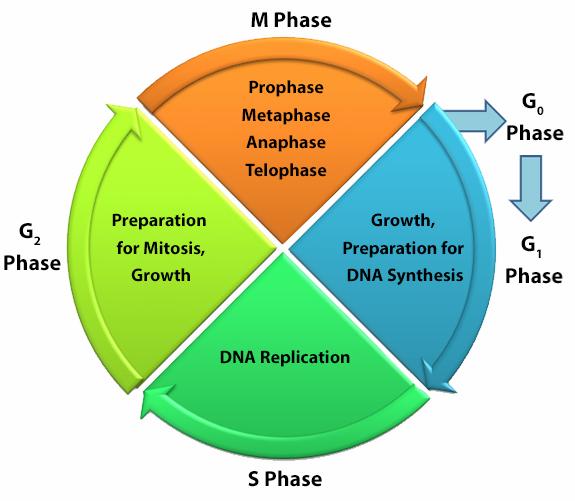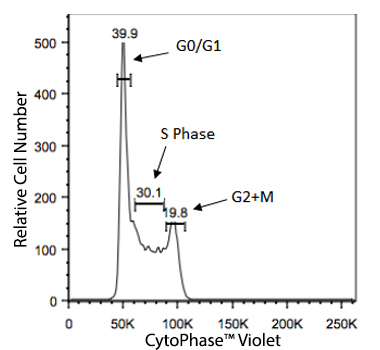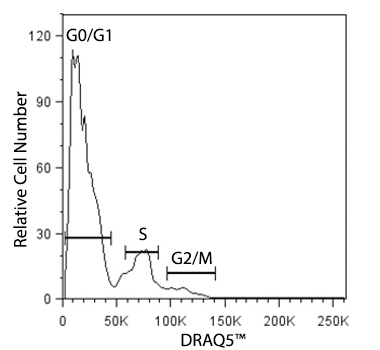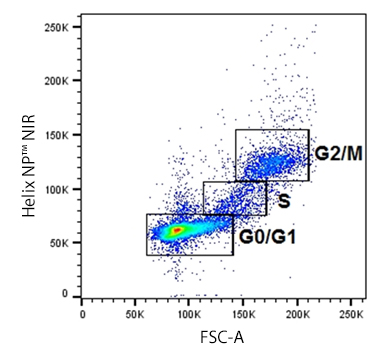While some assays utilize antibodies to study cell health, proliferation, cell cycle or apoptosis, other types of experiments can rely on non-antibody based methods of assessment, often called non-antibody chemical probes. These are reagents that localize to an organelle or indicate health based on chemical characteristics like hydrophobicity, charge, size and enzymatic activation.
Cell Health and Proliferation
Below is a table to aid in reagent choice for cell health and proliferation labeling applications. Cell type suitability indicates whether this reagent labels live cells exclusively or whether it can also label the dead cells in a live cell culture or cells that have been previously fixed with buffers like paraformaldehyde or methanol. Sample suitability indicates whether this reagent can be used to label already fixed tissue sections or single cells in suspension or cell culture. Application indicates their suitability for being analyzed by flow cytometry, microscopy platforms or both. Fixation simply indicates whether the reagent, once used to label a cell sample, will be retained with a paraformaldehyde fixation.
| Cell Type Suitability | Sample Suitability | Application | Fixation | ||||||
| Chemical Probe | Spectra | Subcellular Localization | Live | Dead/ Fixed | Tissue | Cell Culture/ Single Cells | Flow Cytometry | Microscopy | Retention with PFA Treatment |
| Autophagy Detection Probe Green | Exmax/Emmax 485, 530 nm |
Autophagosome | • | • | • | ||||
| Golgi Detection Probe Red | Exmax/Emmax 544, 570 nm |
Golgi Apparatus | • | • | • | ||||
| Lysosome Probe Green | View Spectra | Lysosome | • | • | • | • | |||
| Lysosome Probe Orange | View Spectra | Lysosome | • | • | • | • | |||
| Lysosome Probe Red | View Spectra | Lysosome | • | • | • | • | |||
| Lysosome Probe Deep Red | View Spectra | Lysosome | • | • | • | • | |||
| Lysosome Probe NIR | View Spectra | Lysosome | • | • | • | • | |||
| JC-10 Mitochondrial Membrane Potential Kit | View Spectra | Mitochondria | • | • | • | • | |||
| MitoSpy™ Green FM | View Spectra | Mitochondria | • | • | • | • | |||
| MitoSpy™ Orange CMTMRos | View Spectra | Mitochondria | • | • | • | • | • | ||
| MitoSpy™ Red CMXRos | View Spectra | Mitochondria | • | • | • | • | • | ||
| MitoSpy™ NIR DiIC1(5) | View Spectra | Mitochondria | • | • | • | • | |||
| Calcein-AM | View Spectra | Cytoplasm | • | • | • | • | |||
| Calcein Red-AM | View Spectra | Cytoplasm | • | • | • | • | |||
| Calcein Violet-AM | View Spectra | Cytoplasm | • | • | • | • | |||
| CFSE | View Spectra | Cytoplasm | • | • | • | • | • | • | |
| Tag-it Violet™ | View Spectra | Cytoplasm | • | • | • | • | • | • | |
| Helix NP™ Blue | View Spectra | Nucleus | • | • | • | • | • | ||
| Helix NP™ Green | View Spectra | Nucleus | • | • | • | • | • | ||
| Helix NP™ NIR | View Spectra | Nucleus | • | • | • | • | • | ||
| CytoPhase™ Violet | View Spectra | Nucleus | • | • | • | • | • | • | |
| DRAQ5™ | View Spectra | Nucleus | • | • | • | • | • | • | |
| DRAQ7™ | View Spectra | Nucleus | • | • | • | • | • | ||
| 7-AAD | View Spectra | Nucleus | • | • | • | • | • | ||
| Propidium Iodide | View Spectra | Nucleus | • | • | • | • | • | ||
| DAPI | View Spectra | Nucleus | • | • | • | • | • | ||
| Zombie Dyes | View Spectra | Cell Surface or Cytoplasmic Primary Amines | • | • | • | • | • | ||
| Apotracker™ Green | View Spectra | Phosphatidylserine | • | • | • | • | • | ||
| Annexin V | Several formats available | Phosphatidylserine | • | • | • | • | |||
| Flash Phalloidin™ Green 488 | View Spectra | Actin | • | • | • | • | N/A | ||
| Flash Phalloidin™ Red 594 | View Spectra | Actin | • | • | • | • | N/A | ||
Cellular division for any cell type is dependent on the inherent function, location and the response of cells to repair, apoptosis, or death. To divide, cells must duplicate a copy of their DNA, increase mitochondrial density, and assemble/synthesize microtubules during interphase. G2 is a checkpoint stage of interphase where the cell has two sets of dsDNA and must commit to mitosis. Mitosis is the actual division stage where two daughter cells are created. There can be symmetrical or asymmetrical division depending on the cell and tissue type. Mitosis can be further subdivided into prophase, metaphase, anaphase, and telophase as the nucleus undergoes division and chromatids are pulled away from one another. After mitosis, the cell will undergo the G0/G1 phase when the cells rest to become ready for the next round of replication.

During G0/G1, S, and G2 phases, some fluorogenic nucleic acid stains selectively bind dsDNA stoichiometrically to give us measurements of DNA mass based on fluorescence intensity. Cell-permeant nucleic acid stains can be used in instances where cells will be analyzed live. Propidium Iodide, DAPI, DRAQ5™, DRAQ7™, CytoPhase™ Violet, Helix NP™ NIR, Helix NP™ Blue, and Helix NP™ Green can all be used to stain fixed cells for cell cycle analysis. However, only CytoPhase™ Violet and DRAQ5™ can be used to assess DNA content of live cells.
For additional reagents (including antibodies) on cell cycle analysis or DNA replication, check here.
CytoPhase™ Violet

Live Ramos cells treated with 5 µM CytoPhase™ Violet dye for 90 minutes at 37°C.
DRAQ5™

Live C57BL/6 mouse bone marrow cells were stained with DRAQ5™.
Helix NP™ NIR

C57BL/6 mouse thymus cells were fixed using 70% chilled ethanol. The cells were incubated for one hour at -20°C, washed, then stained with Helix NP™ NIR at 5 µM.
 Login/Register
Login/Register 






Follow Us